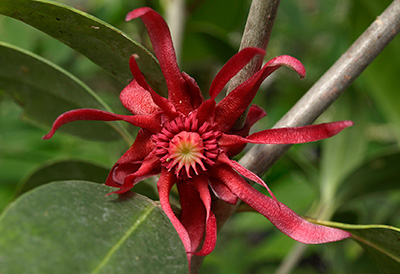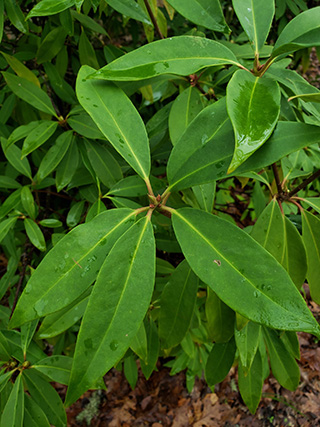Florida Anise

Florida anise offers something different to the landscape outside of traditionally used shrubs. This native shrub is low-maintenance and sports showy blossoms. Perfect for a woodland setting, this less-common evergreen is well adapted to Florida conditions and rarely experiences disease or pest problems.
Characteristics
Florida anise (Illicium floridanum) is native to the state and grows along the coastal plain, from Florida to Louisiana. It works well as a hedge or barrier plant, reaching heights of 10 to 15 feet and a spread of 6 to 10 feet. These shrubs produce dense foliage and create privacy in place of a fence. They also work well when paired with other shrubs, such as camellias and azaleas, as a mixed border. When crushed, the leaves exude a strong licorice aroma. Despite this herb-like fragrance, Florida anise has been reported as toxic when any part of the plant is consumed. However, it’s these toxic oils in the plant that make it less likely to be eaten and therefore resistant to feeding by grazers such as insects and deer.
Florida anise has simple olive-green leaves and in the spring produces small star-shaped maroon flowers, adding a unique pop of color. In the summer to fall, these flowers are followed seed pods that are also shaped like stars.
Planting and Care
Florida anise can be found along shady ravines in the wild, so it’s comfortable with wet conditions. It prefers rich soil and plenty of moisture; however, it’s a hardy shrub and can survive harsher conditions with moderate drought tolerance. It’s well suited for sun or shade, making it a versatile option for your yard. It might thin out when shaded, so if you aim for a denser plant then part-sun would be ideal. The shrub falls into USDA hardiness zones 8 through 10 and can be planted year-round with a relative tolerance for freezes.

Once established, watering will only be required during long droughts. Florida anise also has no known pest or disease concerns, making this shrub a low-maintenance choice. To maintain its form, prune the shrub once a year; it can be trained into a small multi-trunked or single-trunked tree to your liking.
You can find Florida anise at most native plant nurseries and some garden centers. Propagate more of your own via cuttings or layering. If you want to add a unique, native hedge to your yard, Florida anise fits the bill with interesting blooms, expansive foliage, and limited maintenance.
Also on Gardening Solutions
More from UF/IFAS
- Florida Anise: An Underused Native Shrub
- Illicium anisatum, Japanese Anise
- Illicium floridanum Florida Anise Tree, Florida Anise
